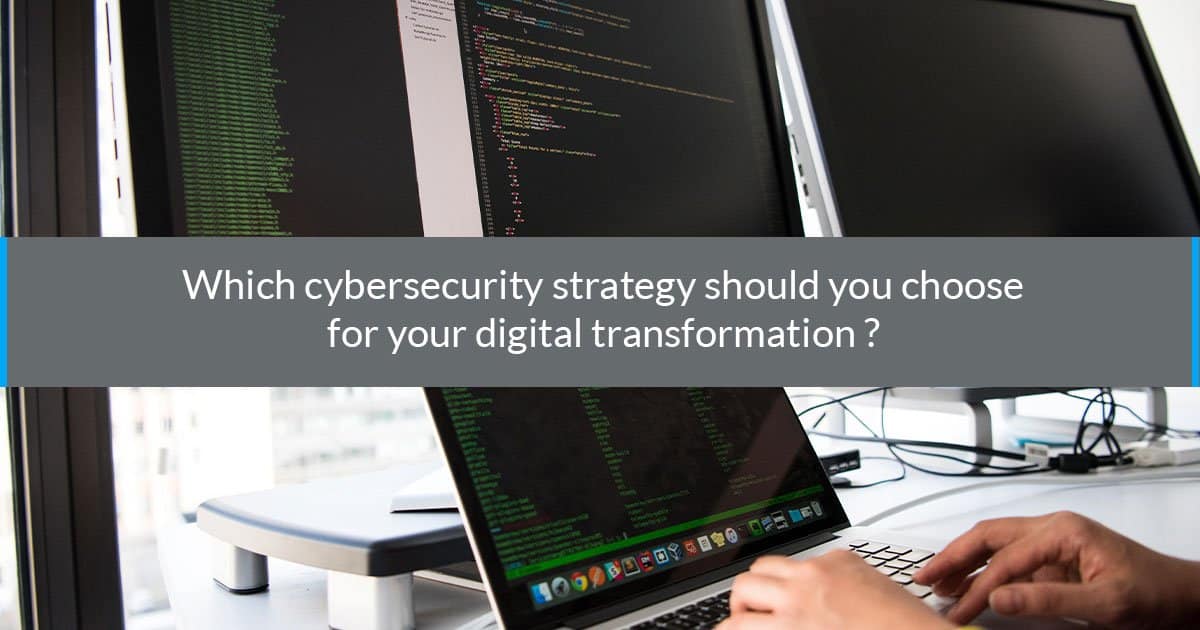The dawning of the digital age has transformed our society. The Internet and the other new technologies have improved our day to day private life and, but they have also negatively impacted our professional life. Due to these changes, many companies are left vulnerable to the inventive attacks of cyber pirates, jeopardising the safety of private data.
Do you want your digital transformation to succeed whilst avoiding risks? Begin by learning about the digital transformation, learn what risks this may contain and how to devise an efficient cybersecurity strategy.
What is the digital transformation?
For an organisation, the digital transformation consists of integrating digital technologies into all activities (source 1h30). This concerns all aspects of a company: production, sales, customer facing roles, communication, human resources, etc. The objective of digital transformation is to reduce cost by increasing productivity and performance. All industry sectors are impacted, from agriculture to banking, tourism, logistics and medicine.
Since the switch to computers and emails, the digital transformation has not stopped transforming the economic model of companies and the way in which employees work together by generalising the usage of the internet and new technologies.
Today, this notably includes:
- The Internet of Things: technology and applications to facilitate the work and improve data collection and analysis.
- Mobility: Thanks to the Internet, it is possible to work anywhere in the world (teleworking), on a train or in an office on the other side of the world.
- Dematerialisation: Thanks to the digitalisation of documents, there is no need to print a contract to sign it. From now on, everything is done online, and data is stored in the cloud.
With the rise of the internet, this technological revolution has not ceased to churn out new tools and new ways of working such as smart phones, tablets, various applications and social networks. For companies, this digital transformation makes it possible to predict new consumption patterns and to better understand their clients and their potential customers in order to better correspond to their needs.
However, this digital transformation is not without risks.
What are the risks associated with the digital transformation?
The digital transformation entails many serious risks. It multiplies the threat of data theft via connected applications, the cloud and the software used at the heart of the company. Furthermore, it results in significant data circulation, manipulation and storage within systems that are not at all or not sufficiently secure and that are managed by employees who are not trained on the potential risks.
Risks concerning system access and data security are therefore considerable. This data, often confidential (financial information, medical data or strategies, etc.) attract formidable cybercriminals and are the target of more and more sophisticated attacks. Extortion of funds, identity theft, breach of trust, bank card fraud, intrusions or spyware program installation, theft, deterioration or destruction of data are just a few examples of different cyberattacks which your company may face.
In the 4th annual Cesin barometer (club of experts in information and digital security), created at the end of 2018 with OpinionWay, 98% of companies surveyed, estimate that the digital transformation (using Cloud and Internet applications) has an impact on information and digital security.
In France, 8 out of 10 companies are affected by cyberattacks every year and 59% of companies surveyed confirm that cyberattacks have had an impact on their company.
To support your digital transformation, a secure cybersecurity strategy is invaluable in order to protect your company and ensure the security of your data.
Which cybersecurity strategy should you implement?
Cyberthreats should not be a hindrance to the performance, innovation and the success of your company and your projects. To protect your brand image and not to lose the trust of your employees, your customers and your business partners, follow this piece of advice to build your cybersecurity strategy
Do not neglect numerical sovereignty
In today’s age, digital sovereignty is very important. Ensure your data is stored in France so that it is under the protection of French law and jurisdiction.
Use secure software
Carefully choose the software and applications that you integrate in your company. Check that they comply with the General Data Protection Regulations (GDPR) and that the protection and confidentiality of your data is a priority. For a highly secure collaborative software, confide in Wimi Armoured. As well as providing all necessary features for project management, Wimi Armoured guarantees the security, confidentiality and sovereignty of your data.
Train your employees
According to Techradar, 90% of data breaches are due to human error. In fact, every day, your employees could be the target of cybercriminals, notably via phishing mails which contain viruses or malwares (malicious software) etc. Hence the need to train them on the risks and threats they may face every day.
Give them concrete examples of cyberattacks, teach them to respond efficiently and put in place a procedure to follow in case of data attacks.
Find a balance between security and creativity
Implementing better cybersecurity measures within your company’s needs should not be at the expense of other initiatives or the creativity and innovativeness of your employees. Choose collaborative tools that allow the secure data sharing between everyone involved in a project (employees, customers, suppliers, service providers, etc.).
Integrate cybersecurity in your company strategy
To effectively combat cyber threats, you need to develop a new security strategy, design new processes and learn new skills. This cybersecurity strategy must be integrated into your company’s overall strategy and aligned with its needs.
To implement your cybersecurity strategy, you should train staff internally or use an external provider. It is imperative to monitor threats carefully, respond appropriately, and then analyse and correct the situation to ensure that these incidents will not happen again. The safety of your data is in your hands!










